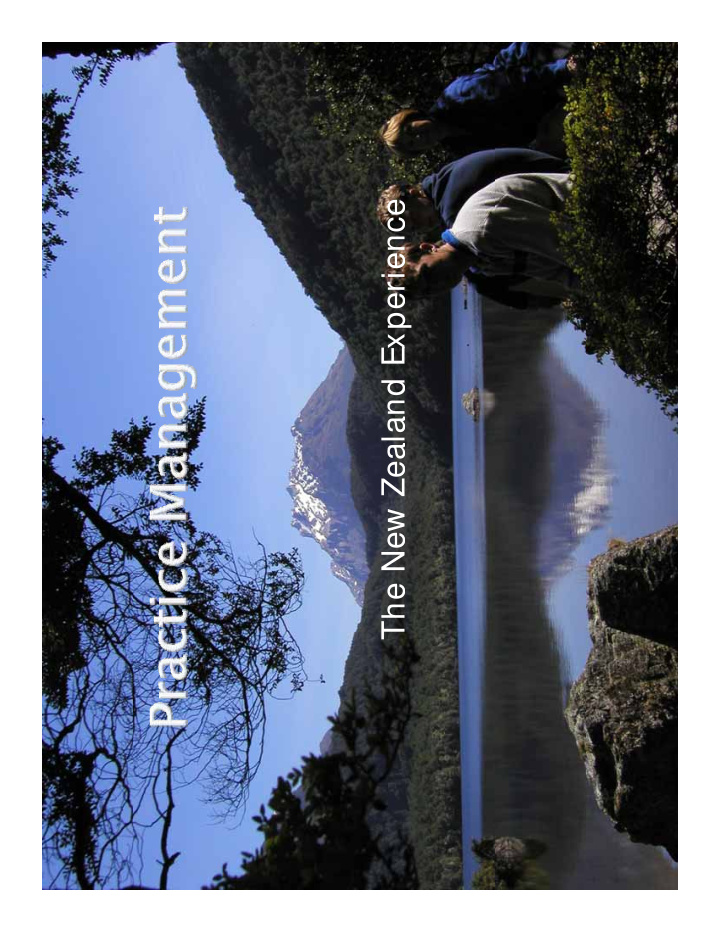



The New Zealand Experience. p
� Ruth Vause. Practice Manager, Redwoodtown Doctors, Blenheim � Executive member of New Zealand Practice Managers and Administrators Association of New Zealand New Zealand. � PHO Practice Manager Facilitator � RNZCGP Cornerstone Practice Assessor � RNZCGP Cornerstone Practice Assessor.
� Small Businesses. � Ownership. Mostly GP owned. Limited emergence of community trust or tribal ownership ownership. � Size. Solo to 20 plus GPs. Average is 3.5 . � Size 1 GP 1500 urban 1 GP 1200 Rural � Size. 1 GP 1500 urban, 1 GP 1200 Rural. � Practice team. GPs, Practice Nurses, Reception,Administration and Practice Reception,Administration and Practice Manager.
� Ministry of Health. Funders and policy. � Primary Health Care Strategy. Population health and personal health. � Organisation of primary care. MOH- DHB- O i i f i MOH DHB PHO. � Funding Mixed revenue Capitation and Fee � Funding. Mixed revenue. Capitation and Fee for service. Patient copayments. � Health and Disability- Code of patient rights. � Health and Disability Code of patient rights. � ACC No fault accident legislation. � Over 30 Acts to comply with. p y
� 3.5 GPs, 5 all working part time or multiple roles. � Nursing staff. 3 with a practice assistant. � 4 Reception and administration team. � Practice Manager. � Teaching practice. New graduate nurses and 5 th year medical students. d 5 th di l t d t � Accredited. � Fully computerised electronic medical � Fully computerised electronic medical records. PMS with secure national intranet.
� Practice management is emerging mostly as specialised operational management. � GP shortage. Increasing complexity. � Increasing compliance. HR, contractual, legal. I i li HR l l l � Change in funding fee for service to capitation 100% practices have migrated capitation. 100% practices have migrated. � Contracting to PHO. � Practice accreditation � Practice accreditation.
Overview of Overview of Practice Managers Role Practice Managers Role Planning Planni ng Clin Clinical O ical Operatio ions Human Human Financial ncial Professional Professional Resource Resources Responsi Responsibility b l b l ity Risk Risk Manage Manageme ment nt Leadership Leadership IT IT IT IT Mission Mission Practice Organisation Practice Organisation To provi To provide e quality patie quality patient t centered ered c care Outpu Outputs Mana Management S g g ement Significant g g nificant Complaint Com p laint Even Events resolution resolution Accreditation - meeting standards Accreditation - eeting standards High staff morale/ low turnover High staff morale/ low turnover A A Appropr ppropriate i i ate Access A ccess Improve I I mproved Capac d d C apacity i ty P Pat P atient sat i i ent satisfact i f action i on Improved Clinical Improved Clinical Outcome Outcome
� 100% practices have PMS. 90% EMR Effi i Efficiency. Staff time and space. St ff ti d Reception – triage. Alerts. Timetabling. Timetabling Program management i.e. breast screening screening. Patient register and PHO reporting. Financials Financials. Access from a distance. Task Management Task Management.
� Commonality of role. � Isolated in our practices I l t d i ti � Need to network for sharing and learning.. � Need to organise ourselves to meet � Need to organise ourselves to meet professional needs. � Constituted a membership organisation. � Constituted a membership organisation.
� Employers and key stakeholders- to understand the scope of management role. � Risk management, business and patient safety safety. � Role in the delivery of quality. RNZCGP. Professional/ patient/ practice Professional/ patient/ practice. � Team leadership. Overveiw of organisation. � Change management. � Change management.
� Membership organisation. 350 members . p g � National Executive with local branches. � National Executive engages in strategic planning to support our mission. l � Developed relationships with key stakeholders. � Qualification- step to professional status. Qualification step to professional status � Salary survey and scopes of practice management. management. � Annual conference. � Local branch meetings and national newsletter. g
� 100% Accreditation. Business aligned with philosophy of Family Medicine. hil h f F il M di i � Changing contractual obligation. Move to performance focus. PMP and funding. performance focus. PMP and funding. � Chronic conditions management. � Shift secondary services to primary settings. (Starfield – better population based (S fi ld b l i b d outcomes. ) � Training practices: Nurse and Doc tor � Training practices: Nurse and Doc tor � Practice Manager role: qualifications and development of professional status.
� Opportunity to engage in quality management. t � Framework. RNZCGP recognises the “practice” practice � Assisted in developing indicators for NZ tool. Cornerstone. � Examples. Managing professional E l M i f i l development to meet practice needs. Strategic and business planning. Significant Strategic and business planning. Significant event management. HR. Patient Safety- triage, test results, prescribing.
� Recognition of practice managers. Both in selection of indicators, assessors and practice role. � Improved practice performance and � Improved practice performance and capability and capacity. Move from day to day administration to quality management. (QA administration to quality management. (QA and CQI) � Practice management resource development. RNZCGP, NZMA, IPA, private.
� Professional recognition by fellow professional bodies bodies. � Step up - Qualification- code of ethics and PD. � Role recognition by employers. g y p y � Role recognition by MoH and funding organisations. � Resource development � Resource development. � Quality management. Standard setting and CQI. � Change management. � Peer support. � Education.
Recommend
More recommend